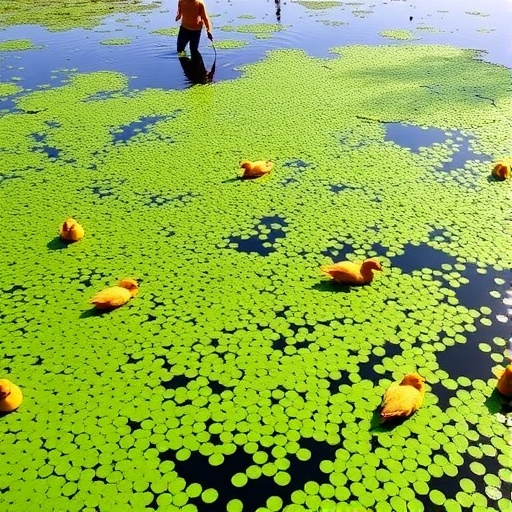In the quest to sustainably feed a growing global population, nitrogen management within rice paddies has become a critical scientific frontier. Nitrogen fertilizers are indispensable for achieving high yields in rice production, a staple crop feeding nearly half the world’s population. Yet, the environmental consequences of nitrogen fertilizer use—chiefly the release of reactive nitrogen gases—pose significant challenges. In a groundbreaking study recently published in the journal Nitrogen Cycling, researchers have elucidated the multifaceted role of duckweed (Lemna minor L.) in modulating nitrogen gas fluxes from paddy soils, uncovering both its potential and its complexities in mitigating agricultural pollution.
Duckweed, a tiny yet fast-growing aquatic plant, has been explored for its capacity to influence nitrogen dynamics in flooded rice fields. The study’s experimental framework incorporated state-of-the-art high-precision gas exchange measurement chambers, allowing for the rigorous quantification of five reactive nitrogen gases: nitrous acid (HONO), nitrogen oxides (NOx), ammonia (NH3), nitrous oxide (N2O), and related nitrogen compounds. The experimental design contrasted bare soil conditions, nitrogen-fertilized soil, and nitrogen-fertilized soil coupled with duckweed coverage, thus teasing apart the plant’s direct and indirect effects on nitrogen emissions.
The results revealed a striking reduction in emissions of nitrogen oxides and nitrous acid when duckweed was present—a greater than 70 percent decrease in HONO and over 50 percent reduction in NOx compared to fertilized soil without duckweed. These gases are notorious contributors to atmospheric pollution and acid rain, and their suppression holds notable promise for air quality improvement. The mechanism underpinning this suppression was traced to duckweed’s modification of the soil microenvironment. By floating on the water surface, duckweed alters redox potential—shifting soil chemistry toward more oxidized conditions—and elevates pH levels. These changes foster a microbial community that favors pathways limiting reactive nitrogen oxide production, effectively transforming the biogeochemical cycling of nitrogen in the paddy ecosystem.
However, the study highlights a challenging trade-off. While the duckweed cover curtails nitrogen oxide emissions, it inadvertently stimulates a dramatic escalation of ammonia and nitrous oxide release. Ammonia emissions surged by a staggering 140-fold, and nitrous oxide emissions increased threefold compared to the fertilized control without duckweed. Nitrous oxide is a particularly potent greenhouse gas, with a global warming potential substantially exceeding that of carbon dioxide. The researchers attribute these elevated emissions to the decomposition of duckweed biomass, which introduces labile organic carbon and nitrogen into the soil. This influx fuels microbial processes such as nitrification and denitrification, intensifying the release of ammonia and N2O into the atmosphere.
Delving into the molecular realm, the researchers employed advanced metagenomic and transcriptomic tools to map shifts in the soil microbiome’s functional gene expression. Significant upregulation of genes associated with denitrification—as well as ammonia production—was documented in duckweed-treated soils. This genomic activation suggests that duckweed not only reshapes the chemical environment but actively remodels microbial metabolic pathways, steering nitrogen transformations toward enhanced gaseous loss. These findings underscore the intricate feedbacks between plant biomass input, soil chemistry, and microbial community dynamics underpinning nitrogen gas fluxes.
This complexity spotlights a critical implication: natural interventions that appear environmentally advantageous can incur unintended consequences if implemented in isolation. Duckweed, while reducing harmful nitrogen oxides, simultaneously amplifies emissions of other environmentally detrimental gases. Consequently, the study advocates a nuanced, integrated approach toward deploying duckweed in rice agriculture. Such strategies might involve periodic harvesting of duckweed biomass to prevent its decomposition on-site, thereby halting the chain reaction of increased ammonia and N2O emissions.
Additional soil amendments could further optimize outcomes. For instance, biochar incorporation might stabilize soil nitrogen and sequester carbon, while nitrification inhibitors can slow microbial conversion processes, collectively reducing gaseous nitrogen losses. These additive measures could leverage duckweed’s benefits while mitigating its drawbacks, positioning it as a component within a sophisticated toolkit for sustainable nitrogen management in rice paddies.
Co-author and senior researcher Dr. Zhimin Sha stresses that duckweed should not be seen as a silver bullet but rather as a promising piece in a complex puzzle. The research team calls for long-term, field-based studies to validate lab findings and quantify real-world impacts across diverse environmental conditions and rice cultivation systems. Such comprehensive monitoring is essential for developing adaptable, multifunctional approaches that reconcile agricultural productivity with environmental stewardship.
This study offers a paradigm shift in how biological interventions are evaluated in agroecosystems. It moves beyond simplistic assessments toward mechanistic insights into microbial ecology, biogeochemical feedbacks, and gas flux interactions. The researchers’ careful dissection of duckweed’s dual role serves as a cautionary tale against one-dimensional thinking and exemplifies the necessity of system-level perspectives in tackling global environmental challenges tied to food production.
In sum, the mechanistic evaluation of duckweed’s influence on nitrogen gas emissions represents a significant advance in understanding the subtleties of nitrogen cycling under flooded conditions. Its findings illuminate the promise and pitfalls of leveraging natural biological processes to curb harmful emissions from one of the planet’s most important crops. The enduring lesson is the power—and complexity—of tiny plants in shaping planetary-scale environmental outcomes, affirming the need for precision and integration in the design of sustainable agricultural practices.
Subject of Research: Not applicable
Article Title: Mechanistic evaluation of duckweed intervention on reactive nitrogen gas fluxes from paddy soils
News Publication Date: 28-Oct-2025
Web References: https://www.maxapress.com/nc
References: Lan Y, Xu S, Liu X, Li D, Chu Q, et al. 2025. Mechanistic evaluation of duckweed intervention on reactive nitrogen gas fluxes from paddy soils. Nitrogen Cycling 1: e008
Image Credits: Yiyu Lan, Shuhan Xu, Xiangyu Liu, Detian Li, Qingnan Chu, Dianming Wu, Yanwen Xu, Ping He, Chengrong Chen & Zhimin Sha
Keywords: Nitrogen, Nitrogen cycle, Sustainable agriculture




